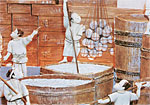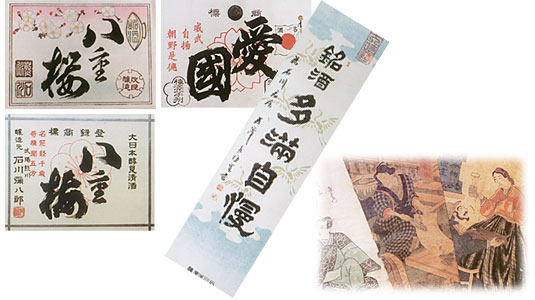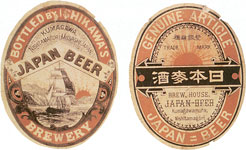 The
history of Ishikawa Brewery started on September 1, 1863 (under the old
calendar). The original location of the brewery was in Ogawa village on
the opposite bank of the Tama River. Ishikawa Brewery had a Tanauchi relationship
with Tamura Shuzoujou. (The members in that relationship originally worked
for one original business organization and are now working for the original
organization or another that branched from the original and runs the same
type of business; they are tied with blood or former master-servant relationship.)
In 1881, Ishikawa Brewery built a new kura (storehouse) in the
present Kumagawa area and, in 1883, the whole business finished moving
to this location. Ishikawa Brewery earlier used "Yae-zakura"
(double-flowered cherry) as a brand name at first after the establishment
of the business. This brand name showed the sister-company relationship
with Morita Shuzo in Ogawa village who brewed "Yae-giku" (double-flowered
chrysanthemum). In 1919, the brand was renamed "Yae-ume" (double-flowered
plum), and in 1933, the present brand name, "Tamajiman," came
to be used.
The
history of Ishikawa Brewery started on September 1, 1863 (under the old
calendar). The original location of the brewery was in Ogawa village on
the opposite bank of the Tama River. Ishikawa Brewery had a Tanauchi relationship
with Tamura Shuzoujou. (The members in that relationship originally worked
for one original business organization and are now working for the original
organization or another that branched from the original and runs the same
type of business; they are tied with blood or former master-servant relationship.)
In 1881, Ishikawa Brewery built a new kura (storehouse) in the
present Kumagawa area and, in 1883, the whole business finished moving
to this location. Ishikawa Brewery earlier used "Yae-zakura"
(double-flowered cherry) as a brand name at first after the establishment
of the business. This brand name showed the sister-company relationship
with Morita Shuzo in Ogawa village who brewed "Yae-giku" (double-flowered
chrysanthemum). In 1919, the brand was renamed "Yae-ume" (double-flowered
plum), and in 1933, the present brand name, "Tamajiman," came
to be used.
Below: Sake trademark of Ishikawa Brewery
Below at right: Souvenirs from Edo
When the brewers returned to their hometowns, they took these items home
as souvenirs, pasted to folding screens, etc., and valued them.

